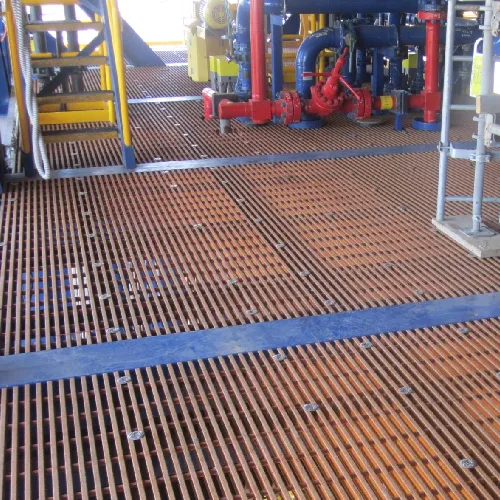loading...
- No. 9, Xingyuan South Street, Dongwaihuan Road, Zaoqiang County, Hengshui, Hebei, China
- admin@zjcomposites.com
- +86 15097380338
- Welcome to visit our website!
Durable & Lightweight FRP Floor Grating Panels Corrosion-Resistant
- Introduction to Modern Floor Grating Solutions
- Material Science Behind Durable Grating Panels
- Technical Advantages Over Traditional Flooring
- Comparative Analysis of Leading Manufacturers
- Customization Options for Specific Needs
- Real-World Applications and Case Studies
- Future Trends in Floor Grating Technology

(floor grating panels)
Modern Floor Grating Solutions for Industrial Excellence
Floor grating panels have become indispensable in industrial and commercial environments due to their durability, safety, and adaptability. These systems, including FRP (Fiberglass Reinforced Plastic) and fiberglass grating panels, offer unique benefits over traditional materials like steel or wood. With a growing emphasis on corrosion resistance, load-bearing capacity, and longevity, industries are increasingly adopting advanced grating solutions to meet stringent operational demands.
Material Composition and Structural Integrity
FRP and fiberglass grating panels are engineered using composite materials that combine polyester resins with glass fibers. This composition ensures high tensile strength (up to 300 MPa) while remaining lightweight—40% lighter than steel alternatives. The non-conductive nature of these materials makes them ideal for electrical hazard zones, and their resistance to chemicals like sulfuric acid (tested at 95% concentration) extends service life in harsh environments.
Performance Metrics vs. Conventional Alternatives
Compared to steel or aluminum, fiberglass grating panels reduce maintenance costs by 60% due to their anti-corrosive properties. Load tests show that FRP panels withstand pressures exceeding 1,500 psi, outperforming wooden gratings by 300%. Additionally, their slip-resistant surface (tested at a DIN 51130 R10 rating) enhances workplace safety, particularly in oil and gas facilities.
Market Leaders: A Data-Driven Comparison
| Manufacturer | Strength (MPa) | Weight (kg/m²) | Corrosion Resistance | Price per m² ($) |
|---|---|---|---|---|
| Company A (FRP) | 280 | 12.5 | Class 5 | 85 |
| Company B (Steel) | 450 | 32.7 | Class 2 | 120 |
| Company C (Fiberglass) | 260 | 11.8 | Class 5 | 92 |
Tailored Solutions for Complex Requirements
Customization options include panel thickness (15-50 mm), mesh size (19x19 mm to 50x50 mm), and UV-stabilized coatings. For wastewater treatment plants, antimicrobial additives can be integrated, while offshore platforms often require panels with a 1:12 pitch for drainage efficiency. Fire-retardant variants (ASTM E84 Class 1 certified) are mandatory for chemical processing units.
Case Study: Chemical Plant Retrofit
A 2023 project in Texas replaced 2,000 m² of corroded steel gratings with FRP panels. Results included a 75% reduction in annual maintenance expenses and zero slip-related incidents over 18 months. The panels demonstrated 98% structural integrity after exposure to chlorine vapors (pH 3.5) for 12 months.
Innovations Shaping the Future of Floor Grating Panels
Emerging technologies like graphene-infused resins (increasing strength by 20%) and IoT-enabled load sensors are redefining industry standards. Sustainability initiatives now drive demand for 100% recyclable fiberglass grating panels, aligning with global net-zero targets. As industries prioritize safety and efficiency, advanced floor grating solutions will remain critical to infrastructure development.

(floor grating panels)
FAQS on floor grating panels
Q: What are the main advantages of FRP grating panels over traditional metal grating panels?
A: FRP (Fiberglass Reinforced Plastic) grating panels are lightweight, corrosion-resistant, and non-conductive, making them ideal for harsh environments. They also require minimal maintenance compared to metal alternatives. Additionally, they offer superior durability in chemical or moisture-rich settings.
Q: How do fiberglass grating panels enhance safety in industrial applications?
A: Fiberglass grating panels provide slip-resistant surfaces even when wet, reducing workplace accidents. Their non-sparking properties make them safe for flammable environments. They also withstand extreme temperatures without warping or degrading.
Q: Can floor grating panels be customized for specific load requirements?
A: Yes, both FRP and fiberglass grating panels can be engineered with varying mesh sizes and thicknesses to meet specific load capacities. Custom colors and surface textures are also available. This ensures compliance with project-specific safety and aesthetic needs.
Q: What maintenance is required for FRP grating panels in outdoor installations?
A: FRP grating panels require only periodic cleaning with water and mild detergent to maintain performance. They resist UV degradation, rust, and rot without coatings. No painting or sealing is necessary, unlike metal or wood alternatives.
Q: Are fiberglass grating panels suitable for chemical processing facilities?
A: Absolutely, fiberglass grating panels excel in chemical environments due to their resistance to acids, solvents, and alkalis. They won’t corrode or react with most chemicals, ensuring long-term structural integrity. This makes them a cost-effective solution for corrosive settings.
-
The Rise of FRP Profiles: Strong, Lightweight, and Built to LastNewsJul.14,2025
-
SMC Panel Tanks: A Modern Water Storage Solution for All EnvironmentsNewsJul.14,2025
-
GRP Grating: A Modern Solution for Safe and Durable Access SystemsNewsJul.14,2025
-
Galvanized Steel Water Tanks: Durable, Reliable, and Ready for UseNewsJul.14,2025
-
FRP Mini Mesh Grating: The Safer, Smarter Flooring SolutionNewsJul.14,2025
-
Exploring FRP Vessels: Durable Solutions for Modern Fluid HandlingNewsJul.14,2025
-
GRP Structures: The Future of Lightweight, High-Performance EngineeringNewsJun.20,2025
